I had visited the Australian Audio & AV Show 2011 which was held at the Marriott Hotel in Melbourne over two days. Here I had noticed certain trends being marked out as far as hi-fi and home-theatre technology went.
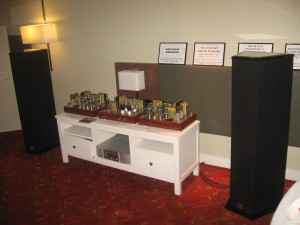
The old-school of hi-fi lives on with these valve (tube) amps
There was interest in orthodox hi-fi setups where vinyl records or CDs were the main medium of choice. These still appeal to the music listeners who prefer to make a point out of listening to their favourite recordings. Here, there was a large number of amplifiers that were driven by valve (tube) technology which appealed to audiophiles who placed value on the “valve and vinyl” style of hi-fi enjoyment. It even showed that there was still life in the “old girl” that was the classic vinyl record, This was more so with the arrival of newly-issued recordings on what I call “boutique vinyl” i.e. records that were cut for best dynamic range and pressed on heavier discs that were made of new material; with the ability for the purchaser to download MP3s of the same recordings for free.

Marantz CR603 CD receiver
Of course, I had seen the return of Luxman to the hi-fi scene, with their efforts on high-grade CD players and stereo amplifiers, with one of their amplifiers being modelled on a 1970s-era classic of theirs.
Network audio
But the main focus of the show was the use of computer equipment and home networks to play out music through hi-fi systems.
Network setups

A router and DLNA-enabled ReadyNAS is what this show is about
Most manufacturers which were demonstrating network-based hi-fi setups had a small network in their hotel rooms. This typically had a wireless router that was fit for home or small-business use at the “edge” of each of these network and working as the DHCP server; the same as what would be expected for a home network. As well, a lot of the manufacturers hooked a network-attached storage unit like the ReadyNAS to these networks to demonstrate their network-audio equipment.
In some cases, some of the suppliers used computers running DLNA-compliant media server software on the network rather than a NAS. An example of this was NAD who linked a MacBook Pro running Elgato EyeConnect as a media server for their C446 Digital Media Tuner.
Network-audio equipment
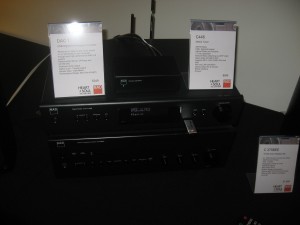
NAD c446 Network Media Tuner
Most of the equipment shown was network-audio adaptors which were known by names as “media tuners”, “Internet tuners”, “network media receivers” and similar names. These were components that were connected to existing amplifiers through a line-level connection and could play content on a DLNA media server, USB memory key or Internet-radio services. Some of the units could connect to and control an iPod attached to their USB port.
Some of these are devices that I have cited in a previous article on this site about top-shelf hi-fi names using DLNA as their preferred network-audio infrastructure. Here, I had mentioned about them using this established technology and the high-grade codecs like FLAC so they can concentrate on high-quality clear sound.
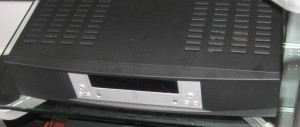
Linn Majik DS network preamplifier
Linn had a handful of these devices which worked as control amplifiers for use with power amplifiers or active speakers. These Akurate, Majik and Klimax units could also stream line-level signals or, as I have seen, the output of a turntable (Linn Sondek LP12) playing a record to other Linn network media adaptors.
As well, some of the manufacturers were offering receivers and CD-receiver systems that had DLNA media playback and Internet media access as part of their function set. This included the Rotel RCX-1500 CD receiver that I have previously reviewed on this site. Speaking of which, Rotel’s Australian distributors, International Dynamics are introducing more network-enabled kit from Pro-ject, in the form of another network media adaptor.
Denon even promoted their network-enabled home-theatre receivers a “everyhing”-ceivers because of the multiple functions that they could offer through the home network.
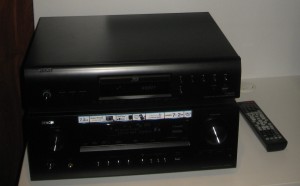
Denon's "everything"-ceiver
All of these setups were based around UPnP AV / DLNA Home Media Networks with Denon, Marantz and B&W demonstrating Apple AirPlay-compliant setups. The sales representatives for most of the various manufacturers had described the UPnP AV / DLNA network setup as an open setup where everyone can “come to the party”. A lot of the setups were controlled using various UPnP AV control points that were running on iPads owned by the various demonstration staff. Some of the control-point apps were branded and optimised for particular manufacturers’ equipment, usually offering control functionality that worked peculiarly with that equipment.
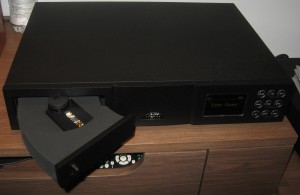
Naim Uniti network CD receiver with Naim's distinct CD-loading tray
Naim and used this show to exhibit their Uniti CD receiver; as well as the UnitiQute network media / FM receiver and the UnitiServer which is their “ripping NAS”. This is a class of NAS which uses an integrated optical drive and software for ripping CDs to the hard disk.
One interesting point that I had noticed was that Loewe had used this event to launch their MediaCenter network-enabled music system. This was equipped with a hard disk and software that allowed you to “rip” the currently-inserted CD to that hard disk, a practice that I had observed with some Philips and other hard-disk-equipped music systems. But this unit was able to share the contents of its hard disk to other UPnP AV client devices as well as become a UPnP AV client device for devices like those NAS units.
How is this becoming relevant to “real” hi-fi?
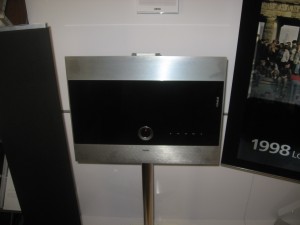
Loewe Mediacenter media server and player
One reason this is happening is that other Websites, fronted by audiophile recording labels, are offering their recordings for purchase and download as high-bitrate FLAC or, in some cases, WMA files. In some cases, these are copies of the studio-master recordings rather than producer-tuned masters for CD and iTunes distribution.
Here, you could load these files on to a NAS and share them through your network with network media clients of this calibre. Or you could use media-management software to transcode to MP3 for use on most portable players and smartphones or prepare CDs of these files for playback on regular CD players.
Conclusion
What I see of this Australian Audio & AV Show this past weekend is that the home network as a system for storing and playing audio content has earned its stripes as far as high-quality sound reproduction is concerned. This is definitely underpinned through the use of the UPnP AV / DLNA standard for discovering and presenting available media content in these networks.








